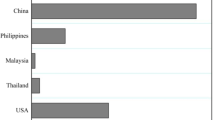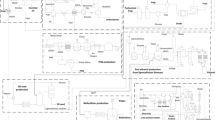Abstract
Nowadays, there are growing concerns about the increased consumption of nonrenewable resources and the impact caused by the conversion of these resources into good and services. Globally, in most cases, only the fleshy part of fruits is consumed; a huge amount of waste (e.g., peel, seed) is generated, which is a nuisance to the environment as a solid waste. Sometimes the generated fruit peel waste (FPW) is more than that of consumed part. At present, FPW seems to be a suitable alternative material for the production of many value-added products. However, its sustainability has been not examined. In this regard, the biorefinery concept offers an opportunity to develop a bio-based economy, given the series of value-added products that can be obtained from this facility. Nonetheless, there are major hurdles that lie ahead for the conversion of FPW into products with value added to their full scope. It is necessary to design an appropriate plan and implement the appropriate technology in order to triumph over these obstacles. As a result, the reuse of FPWs has the potential to develop goods that are both beneficial and profitable, effectively generating “wealth from waste.”
Access this chapter
Tax calculation will be finalised at checkout
Purchases are for personal use only
Similar content being viewed by others
References
Ayala-Zavala JF, Vega-Vega V, Rosas-Domínguez C, Palafox-Carlos H, Villa-Rodriguez JA, Siddiqui MW, Dávila-Aviña JE, González-Aguilar GA (2011) Agro-industrial potential of exotic fruit byproducts as a source of food additives. Food Res Int 44(7):1866–1874
Banerjee J, Singh R, Vijayaraghavan R, MacFarlane D, Patti AF, Arora A (2017) Bioactives from fruit processing wastes: green approaches to valuable chemicals. Food Chem 225:10–22
Canizales L, Rojas F, Pizarro CA, Caicedo-Ortega NH, Villegas-Torres MF (2020) SuperPro Designer®, user-oriented software used for analyzing the techno-economic feasibility of electrical energy generation from sugarcane vinasse in Colombia. Processes 8(9):1180
Capolupo L, Faraco V (2016) Green methods of lignocellulose pretreatment for biorefinery development. Appl Microbiol Biotechnol 100:9451–9467
Clark JH, Deswarte FEI (2008) The biorefinery concept an integrated approach. In: Clark J, Deswarte F (eds) Introduction to chemicals from biomass. Wiley, Hoboken, NJ
Fernando S, Adhikari S, Chandrapal C, Murali N (2006) Biorefineries: current status, challenges, and future direction. Energy Fuel 20:1727–1737
Flora JRV, McAnally AS, Petrides D (1998) Treatment plant instructional modules based on SuperPro Designer® v. 2.7. Environ Model Softw 14(1):69–80
Galbe M, Wallberg O (2019) Pretreatment for biorefineries: a review of common methods for efficient utilisation of lignocellulosic materials. Biotechnol Biofuels 12:1–26
García MÁA, Vargas JHL, Molina DAR (2015) Agro-industrial fruit co-products in Colombia, their sources and potential uses in processed food industries: a review. Revista Facultad Nacional de Agronomía 68(2):7729–7742
Ginni G, Kavitha S, Yukesh Kannah R, Bhatia SK, Adish Kumar S, Rajkumar M, Kumar G, Pugazhendhi A, Chi NTL, Rajesh Banu J (2021) Valorization of agricultural residues: different biorefinery routes. J Environ Chem Eng 9(4):105435
Harun N, Othman NA, Zaki NA, Mat Rasul NA, Samah RA, Hashim H (2019) Simulation of anaerobic digestion for biogas production from food waste using SuperPro Designer. Mater Today Proc 19:1315–1320
Jiménez-Moreno N, Esparza I, Bimbela F, Gandía LM, Ancín-Azpilicueta C (2019) Valorization of selected fruit and vegetable wastes as bioactive compounds: opportunities and challenges. Crit Rev Environ Sci Technol 50(20):2061–2108
Joglekar SN, Pathak PD, Mandavgane SA, Kulkarni BD (2019a) Process of fruit peel waste biorefinery: a case study of citrus waste biorefinery, its environmental impacts and recommendations. Environ Sci Pollut Res 26(34):34713–34722
Joglekar SN, Tandulje AP, Mandavgane SA, Kulkarni BD (2019b) Environmental impact study of bagasse valorization routes. Waste Biomass Valor 10(7):2067–2078
Joglekar SN, Dalwankar G, Qureshi N, Mandavgane SA (2022) Sugarcane valorization: selection of process routes based on sustainability index. Environ Sci Pollut Res 29(7):10812–10825
Kiker GA, Bridges TS, Varghese A, Seager TP, Linkov I (2005) Application of multicriteria decision analysis in environmental decision making. Integr Environ Assess Manag 1(2):95–108
Klein-Marcuschamer D, Simmons BA, Blanch HW (2011) Techno-economic analysis of a lignocellulosic ethanol biorefinery with ionic liquid pre-treatment. Biofpr 5(5):562–569
Leong YK, Chang JS (2022) Valorization of fruit wastes for circular bioeconomy: current advances, challenges, and opportunities. Bioresour Technol 359:127459
Lindeijer E, Guinée JB (2002) Handbook on life cycle assessment: operational guide to the ISO standards. Springer Science & Business Media, New York
Maity SK (2015) Opportunities, recent trends and challenges of integrated biorefinery: Part I. Renew Sustain Energy Rev 43:1427–1445
Manhongo TT, Chimphango AFA, Thornley P, Röder M (2022) Current status and opportunities for fruit processing waste biorefineries. Renew Sustain Energy Rev 155:111823
Nizami AS, Rehan M, Waqas M, Naqvi M, Ouda OKM, Shahzad K, Miandad R, Khan MZ, Syamsiro M, Ismail IMI, Pant D (2017) Waste biorefineries: enabling circular economies in developing countries. Bioresour Technol 241:1101–1117
Ohara H (2003) Biorefinery. Appl Microbiol Biotechnol 62(5–6):474–477
Palgan YV, McCormick K (2016) Biorefineries in Sweden: perspectives on the opportunities, challenges and future. Biofuels Bioprod Biorefin 10(5):523–533
Pathak PD, Mandavgane SA, Kulkarni BD (2015) Fruit peel waste as a novel low-cost bio adsorbent. Rev Chem Eng 31(4):361–381
Pathak PD, Mandavgane SA, Kulkarni BD (2016) Valorization of banana peel: a biorefinery approach. Rev Chem Eng 30(6):651–666
Pathak PD, Mandavgane SA, Kulkarni BD (2017) Valorization of pomegranate peel: a biorefinery approach. Waste Biomass Valor 8(4):1127–1137
Pathak PD, Mandavgane SA, Kulkarni BD (2019) Waste to wealth: a case study of papaya peel. Waste Biomass Valor 10:1755–1766
Pathak PD, Joglekar SN, Mandavgane SA, Kulkarni BD (2021) Fruit peel waste “biorefinery” and sustainability issues. In: Thatoi H, Das SK, Mohapatra S (eds) Bioresource utilization and management. Apple Academic Press, New York
Petti L, Serreli M, Di Cesare S (2018) Systematic literature review in social life cycle assessment. Int J Life Cycle Assess 23(3):422–431
Rivas-Cantu RC, Jones KD, Mills PL (2013) A citrus waste-based biorefinery as a source of renewable energy: technical advances and analysis of engineering challenges. Waste Manag Res 31(4):413–420
Ruiza HA, Conrad M, Sun S-N, Sanchez A, Rocha GJM, Romaní A, Castro E, Torres A, Rodríguez-Jasso RM, Andradee LP, Smirnova I, Sun R-C, Meyer AS (2020) Engineering aspects of hydrothermal pretreatment: from batch to continuous operation, scale-up and pilot reactor under biorefinery concept. Bioresour Technol 299:122685
Saini JK, Gupta R, Hemansi, Verma A, Gaur P, Saini R, Shukla R, Kuhad RC (2019) Integrated lignocellulosic biorefinery for sustainable bio-based economy. In: Sustainable approaches for biofuels production technologies. Springer, Berlin, pp 25–46
Satari B, Karimi K (2018) Citrus processing wastes: environmental impacts, recent advances, and future perspectives in total valorization. Resour Conserv Recycl 129:153–167
Schieber A, Stintzing FC, Carle R (2001) By-products of plant food processing as a source of functional compounds—recent developments. Trends Food Sci Technol 12(11):401–413
Senthil Kumar P, Yaashikaa PR (2020) Sources and operations of waste biorefineries. In: Praveen Kumar R, Gnansounou E, Raman JK, Baskar G (eds) Refining biomass residues for sustainable energy and bioproducts. Elsevier, Amsterdam, pp 111–133
Souza A, Watanabe MDB, Cavalett O, Ugaya CML, Bonomi A (2018) Social life cycle assessment of first and second-generation ethanol production technologies in Brazil. Int J Life Cycle Assess 23(3):617–628
Souza A, Watanabe MD, Cavalett O, Cunha M, Ugaya CM, Bonomi A (2021) A novel social life cycle assessment method for determining workers’ human development: a case study of the sugarcane biorefineries in Brazil. Int J Life Cycle Assess 26(10):2072–2084
Tartrakoon T, Chalearmsan N, Vearasilp T, Meulen UT (1999) The nutritive value of banana peel (Musa sapieutum L.). In: Growing pigs. Deutscher Tropentag, Berlin, pp 1–4
Thomsen TP, Hauggaard-Nielsen H, Bruun EW, Ahrenfeldt J (2011) The potential of pyrolysis technology in climate change mitigation – influence of process design and –parameters, simulated in SuperPro Designer Software. Danmarks Tekniske Universitet, Risø Nationallaboratoriet for Bæredygtig Energi, Denmark
Ubando AT, Del Rosario AJR, Chen WH, Culaba AB (2021) A state-of-the-art review of biowaste biorefinery. Environ Pollut 269:116149
Vlysidis A, Binns M, Webb C, Theodoropoulos C (2011) A techno-economic analysis of biodiesel biorefineries: assessment of integrated designs for the co-production of fuels and chemicals. Energy 36(8):4671–4683
Wadhwa M, Bakshi MPS (2013) Utilization of fruit and vegetable wastes as livestock feed and as substrates for generation of other value-added products. FAO, Rome, pp 1–67
Wang K, Ou L, Brown T, Brown RC (2015) Beyond ethanol: a techno-economic analysis of an integrated corn biorefinery for the production of hydrocarbon fuels and chemicals. Biofpr 9(2):190–200
Yaashikaa PR, Senthil Kumar P, Varjani S (2022) Valorization of agro-industrial wastes for biorefinery process and circular bioeconomy: a critical review. Bioresour Technol 343:126126
Author information
Authors and Affiliations
Editor information
Editors and Affiliations
Rights and permissions
Copyright information
© 2023 The Author(s), under exclusive license to Springer Nature Singapore Pte Ltd.
About this chapter
Cite this chapter
Pathak, P.D., Jadhav, A.R., Deokar, S.K., Jogalekar, S., Gedam, V. (2023). Sustainable Fruit Peel Waste Biorefinery: Challenges and Future Perspectives. In: Pathak, P.D., Mandavgane, S.A. (eds) Biorefinery: A Sustainable Approach for the Production of Biomaterials, Biochemicals and Biofuels. Springer, Singapore. https://doi.org/10.1007/978-981-19-7481-6_14
Download citation
DOI: https://doi.org/10.1007/978-981-19-7481-6_14
Published:
Publisher Name: Springer, Singapore
Print ISBN: 978-981-19-7480-9
Online ISBN: 978-981-19-7481-6
eBook Packages: Biomedical and Life SciencesBiomedical and Life Sciences (R0)




